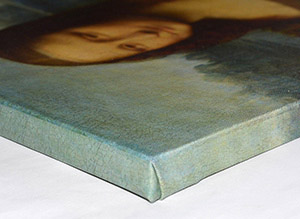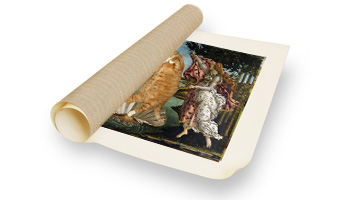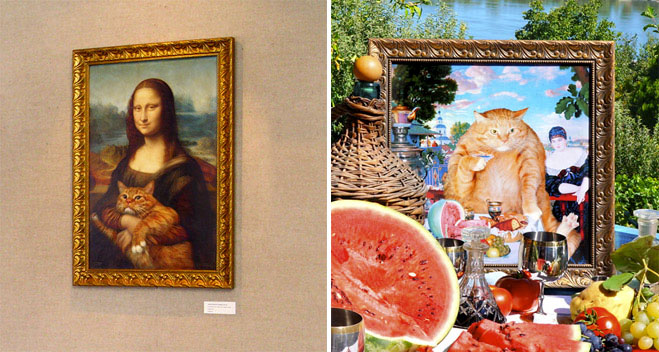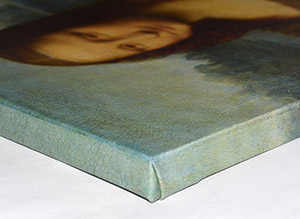How Fat Cat Art pieces are made:
Fat Cat Art is an innovative art project that integrates painting, photography, and digital art.
The artist Svetlana Petrova took photos of her cat Zarathustra when he chose to pose. She made special photo sessions that look like shooting a fantasy movie on a green screen, with Zarathustra as a star.
Then she photoshops the cat into a famous painting’s digital image. The artist paints a lot on the computer and applies complicated techniques. Finally, the cat fits a masterpiece perfectly, as if he was always there, and the new piece of Fat Cat Art is created.
The result is a high-resolution multi-layered digital image that is an original Fat Cat Art piece. This digital creation can appear in real life in multiple ways: it can be printed as a canvas print or poster, or the artist can paint it manually with oil colors as old masters did, or create a mixed media artwork, combining printing and painting.
All the process of printing is made under the strict supervision of the artist, which guarantees quality and correct color rendering.
We print our canvases and posters in Finland, at Dialab Oy, a Hahnemühle Certified Studio and the only certified studio in Finland.
Hahnemühle is a paper manufacturing company in Germany that traces its origins to 1584 and since then produces paper and canvases of exceptional quality.
How we print our posters:
Posters are printed on a special matte 235 gsm thick paper using Epson Ultrachrome natural pigment inks.
The life expectancy of colors of these inks is over 100 years before noticeable fading in a typical home display.
Posters by FatCatArt are long-lasting, beautiful, and eco-friendly.
Posters are certified by the Fat Cat Art emboss stamp on a white margin of a poster
You receive a poster rolled and packed into a hard tube.
How we make our canvas prints:
We print our fine art canvas prints on natural Hahnemühle Acid-free Daquerre 400 gsm cotton canvas. Daguerre Canvas offers a fine structure, which is particularly good for fine art printing.
The canvases are printed using “giclee” technique – an inkjet technique, which was invented specially for high-quality, eco-friendly fine art printing.
We print with Epson Ultrachrome natural pigment inks. These ink don’t tend to channel off which provides us with high-definition and contrast prints. The pigment, i.e. the color matter of the inks, has very high rates of durability – fade resistant guarantee: 118 years.
Thus, Fat Cat Art canvas prints look close to true paintings.
Then a printed canvas is stretched over a stretcher frame made of 20mm bars that are produced from Finnish pinewood. Stretched prints are ready to hang: they are supplied with picture wires on the backside.
A Fat Cat Art print is certified with the artist’s special stamp on the backside of the canvas.
How mixed-media artworks are created:
Mixed media, or, as we sometimes call them, digital paintings, are artworks that combine printing and painting or to say it simply, they are canvas prints, painted manually.
Basements for mixed-media artworks are printed on natural 400 g/m linen canvas for painting, primed, and coated with the special composition for printing. Usage of canvas for paintings instead of the usual canvas for printing is needed because the artist then paints over the print. We print canvases in the “giclee” technique and then stretch them.
Then the artist finishes a canvas of a digital painting manually. She recreates brush strokes using acrylic texture gels and oil colors. The resulting digital painting seems to be a real painting by a master of the past as if a painter really featured Zarathustra the Cat in it.
Mixed-media artworks need a lot of time and skillful handwork to be produced. The brush strokes of the artist make them unique pieces of art. That is why they are way more expensive than canvas prints.
The artist makes mixed-media artworks in limited editions. A limited edition is a series of similar art pieces that are limited in number. Our mixed-media edition size is 8. It means that the artist uses the same image for printing the basement of a mixed-media. This image differs in detail from an image printed on a usual canvas print. Once a limited edition is sold out, the artist destroys the file and new prints of this image will not be produced ever again, and the series become rare. Moreover, each piece within a limited edition differs from the others by the artist’s unique brush strokes. Thus, mixed-media artworks are Fat Cat Art originals.
Digital paintings are certified by the artist’s hand signature and a special document – a certificate of authenticity
Canvas stretching methods
We suggest 2 variants of stretching for our fine art canvas prints:
1. Gallery wrap
Gallery wrap is the method of stretching canvas when the image wraps around the edge of the stretcher frame. The canvas is secured to the stretcher bar by staples applied on the back side of it. Thus the sides of the stretcher bars are covered by an image in the style of the artwork, and it will look fine without a frame. We advise you to choose this method of stretching if you are not planning to put your print in a frame.
2. Without stretching
Without stretching. In this case, prints are shipped rolled up in a rigid tube. You can stretch your print in any atelier nearby. The canvas will include an additional white border enough for stretching it.
All of the mixed-medias are already stretched because the artist works on the stretched canvas. You should put a mixed-media artwork in a frame of your choice
What about framing?
Usually, we don’t supply frames for canvas prints and mixed medias; you can find them in any framing atelier close to your place to your own taste.
Moreover, large and medium-sized framed artworks’ shipping is way more expensive than shipping them non-framed, because of their increased weight and the need for extra packing.
If, nevertheless, you would like to get your print already framed, please contact us, and we can help you and get it framed by our partners.





